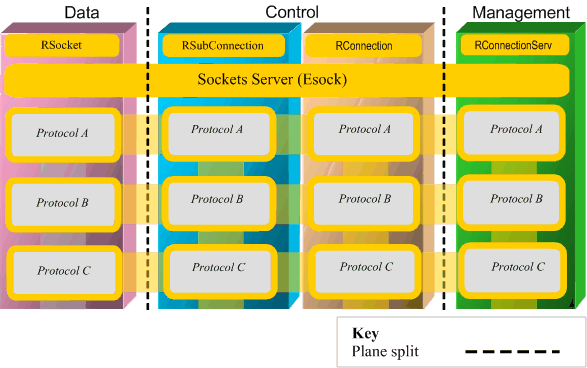What are Planes
This topic describes the concept of a Plane in the Communications Framework.
The transmission of data and the management of connections is divided into separate operations. Symbian platform gives the name Plane to these operations. The Communications Framework defines three Planes. Each Plane has a separate role and a separate responsibility. Each Plane matches a Sockets Server API.
The Planes are called: the Data Plane, the Control Plane and the Management Plane.
Layers span all three Planes. Code in each Plane operates together to deliver the required Communications protocol behaviour.
A connection can have a number of subconnections. Subconnections can be called channels. The concepts of connection and subconnection make it useful to divide the Control Plane into two parts. The following diagram shows the concept. The blue arrows indicate dependencies. The vertical dotted lines indicate the division of Planes.
The following diagram overlays the Planes with an example series of Layers
Data Plane
The Data Plane carries data and uses Communications protocols. The Data Plane handles conversations with remote peers.The Control Plane and the Management Plane exist to serve the Data Plane.
The Data Plane exists to minimise interruptions to the flow of data. The Data Plane assigns the response to interruptions to the Control Plane. Interruptions include: the start of a new network connection, the management of a timeout and the management of changes to the status of the network.
To make sure that interruptions cannot interfere with the Data Plane, a thread divide exists between the Data Plane and the Control/Management Planes. The thread division allows the Communications Framework to give the Data Plane thread a higher priority than the Control and Management Plane thread. The difference in thread priorities allows the Communications Framework to give the task of data transfer the highest priority.
The Communications Framework provides a mechanism to send messages between the threads. The mechanism is called the Message Transport. The Transport sends and delivers the messages asynchronously. Threads can continue their work until the threads are prepared to process messages. The Transport always makes sure of the delivery of messages.
The Data Plane corresponds to the Sockets Server API: RSocket.
The following diagram shows the thread divide.
Features
The Data Plane:
exchanges data with remote peers and uses data transfer protocols
allows any number of conversations at the same time through many protocols
enables the transfer of data to clients of the protocol stack and from clients of the protocol stack
enables the transfer of data to hardware and from hardware
Control Plane
The Control Plane establishes, maintains and modifies the traffic, or conversations in the Data Plane. Specifically, the Control Pane establishes, controls, re-binds and tears down the Communications protocol stack based on commands from the application and from the Management Plane.
The Data Plane sends the status of the link and other control information to the Control Plane. The Control Plane processes the status of the link and other control information, and allows the Data Plane to give the task of data transfer the highest priority.
A connection can have a number of subconnections. Subconnections can be called channels. The concepts of connection and subconnection make it useful to divide the Control Plane into two parts.
The Data Plane corresponds to the Sockets Server APIs: RConnection and RSubConnection.
Features
The Control Plane:
creates the Data Plane
configures the Data Plane modules from information provided by the client application or the Management Plane
starts the Data Plane
controls and monitors the Data Plane:
stops the Data Plane
destroys the Data Plane
manages connection session timers
manages connection data channels and their properties
handles changes to the status of the network and handles error reports
Management Plane
The Management Plane maintains the configuration of the device, monitors the availability of the network and makes policy decisions for the Communications Framework. The Management Plane is the main location where phone creators can customise the behaviour of the Communications protocol stack.
The Management Plane corresponds to the Sockets Server API: RConnectionServ
Features
The Management Plane:
selects, constructs and manages the Communications protocol stack:
notifies interested clients about the state of the Communications protocol stack, for example, bearer and service availability
provides an entry point for third-party plugins to customise and control the Communications protocol stack
controls the Communications protocol stack. This control is based on policy decisions
communicates with the Control Plane to influence the behaviour of Control or Data flow operations in the Communications protocol stack
supplies configuration information to the Layer.


